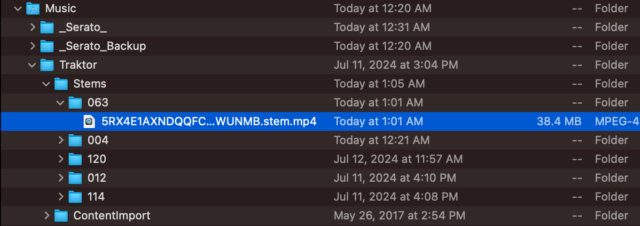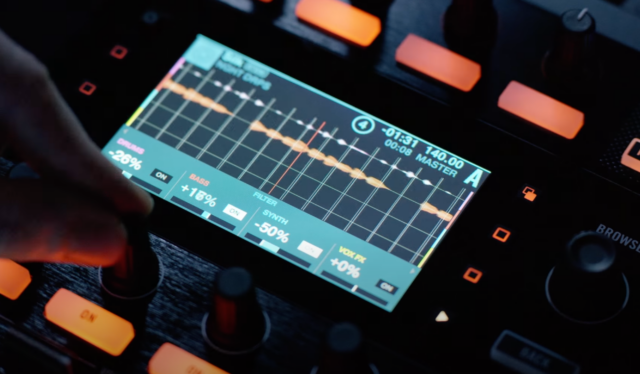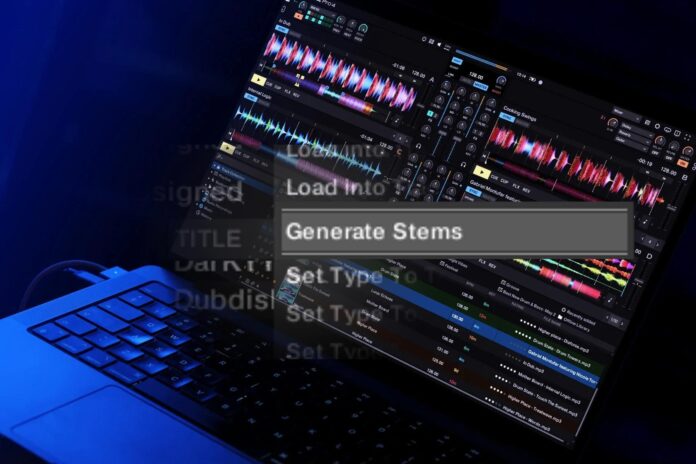Today, Native Instruments is launching Traktor Pro 4. It’s been a long time (6 years, in 2018) since Traktor Pro 3 came out. But the killer feature in today’s Traktor Pro 4 release date goes back even further -to 2014 when the Kontrol S8 and Stem Decks first appeared in the DJ software. In this new version of the software, Native Instruments has launched Stem separation analysis, breaking down your tracks into individual parts and making them playable / effectible / mixable.
In many ways, this is the dream that was foreseen by many in 2015 when Traktor released Traktor Pro 2 with Stem Decks. Instead of needing to buy Stems files made by the producers and labels, advances in modern audio processing algorithms have made on-the-fly stem separation a reality.
Traktor Pro 4 is available today, right now. We’re able to actually sell it digitally – so if you’d like to support DJTT, you can upgrade it here or buy it here.
The upgrade price from Traktor Pro 3 is $74.50, or buy a license outright for $149. It’s not a cheap investment, but we are happy to see that the new killer features aren’t locked behind a subscription model. They’ve also added previous subscription-only features – Pattern Player and Ozone Maximizer – into the base software – so if you’ve missed out on those features in the past, they could be right for as a one-time upgrade.
Is this different from Stems separation in other DJ softwares?

Yes, in terms of the technology behind it, this is different – but the result is very similar. Native Instruments’ Stem separation engine sounds pretty good – so naturally I asked them to share more on what’s behind the tech, suspecting it might have incorporated some of the internal software tools available from their 2021 merger with iZotope. Sure enough – here’s what they said:
Traktor Pro 4 features stem separation powered by AI, and iZotope’s powerful RX technology. We can’t share too many technical details, but we have the same upgraded machine learning as the new RX 11, which is based on the most modern neural network available, plus our own pre and post-processing to further increase the quality of separation. For Traktor, we’ve decided to prioritize quality over speed and have chosen settings that work well across all genres. For now we are not exposing these settings to keep it simple and consistent across the entire collection.
NI’s Stem separation sounds on par with both Serato DJ Stems and Virtual DJ’s Stems 2.0. When I tested all three side-by-side, I was pretty shocked that they were so similar, despite clearly all being based on different tech. (Worth noting I didn’t have a ready-to-test version of Algoriddim djay as they’ve also put a lot of work into their algorithm, – but I plan to later today). The reality is that most stem separation has gotten to a point where it’s good enough for most DJs to use in the mix, but not perfect on it’s own.
The process of analyzing Stems does take some time – in my initial tests, averaging about 30-40 seconds of processing per minute of song separated. I asked NI to share a bit more about if this would get additional optimization down the line and they said:
The current implementation is CPU-based, and optimized for CPU-processing (as opposed to GPU). In a future update we could expose more parameters to give users more control over the speed and quality tradeoff, but we’re waiting for more feedback on the feature as it ships in Traktor Pro 4.0.
How flexible are the Stems when mixing?

Here’s the thing: Native Instruments already put the work in years ago to make a full ecosystem to support Stems mixing. Even pre-Traktor 4, we had heard of DJs who manually separated their collections into stems files and played them back in the software. The implementation hasn’t changed here – DJs see the main waveform on the bottom of the deck, and it’s made up of the individual 4 parts that Traktor splits them into (Drums, Bass, Other, and Vocals).
From my perspective, Traktor Pro 4 has the most flexible Stems mixing controls on the market – with per-Stem volume, filter, and FX send, all of which are MIDI mappable. Again, it’s not a big surprise here because it they’ve had this workflow for a long time, with only the built-in analysis and separation being new.
Worth noting that there’s no seamless way to extract the results of Traktor Pro 4’s stem separation out into a production setting – but you can access the files as multi-track MP4s in Traktor’s data folder in your OS if you wanted to get experimental…

Resurrecting discontinued hardware already built for stems (S8, D2, S5)

Something super interesting about the new release: it brings a fresh new feature to a bunch of different pieces of hardware that have been discontinued by NI. The Kontrol S8, Kontrol D2, and Kontrol S5 all show individual Stems Decks waveforms. I asked NI to share if they had plans to bring any back – and they said:
Our stems will be controllable with any of our hardware that supports dedicated stem controls. Currently there are no plans to revive the D2 and S8, but let’s see how our userbase responds to the new features and take it from there.
I’ve kept a casual but keen eye on Kontrol D2 prices over the years since they were discontinued—and the used market has been very expensive for out-of-production hardware. My best guess is that this will only increase prices even further—they’ve hovered at around $499-$699 (original release price was $499 in 2015).
Similarly, I asked about “club-standard” gear compatability – as Stems have somewhat struggled to get into big DJ booths without a good way to quickly control them. Assuming the D2s aren’t coming back anytime soon, will HID integration with other gear like mixers and CDJs get some Stems features?
This is likely to happen in the future by updating the mappings. But to bring the 4 waveforms onto industry standard displays, we will be depending on the support of the device’s manufacturers.
The other big feature: flexible beatgrids (!)
Flexible beatgrids are now in Traktor Pro 4. This feature must be the longest running request on the Native Instruments docket – I tend to recall back in 2011 reading this as one of the main things DJs wanted to see in a future Traktor version.
Well, at long last, it’s real. Traktor Pro 4’s flexible beatgrids precisely follow each tempo change throughout a track – with Grid Markers now each able to have their own associated tempo. You can manually add your own tempo zones and update the tempo of each, and yes, live-played tracks can be gridded as well by setting a marker every 16 beats – it’s feels fairly similar to manually warping a track in Ableton Live.
Traktor Pro 4’s future
I also asked about the Traktor team, any updates that might relate to Maschine/Stems, and the future roadmaps for Traktor (considering there was a pretty public roadmap revealed with Stems and flexible beatgrids. Their response was promising, if currently vague:
The team has grown over the past year, and we have a rich roadmap ahead of us for the Traktor ecosystem. We decided not to share our Traktor roadmap with this release […] in the meantime, we’ll be closely listening to feedback from this release and steering development priorities accordingly.
Alright – now back to the lab for a bit more testing. Again, if you want to get the new version of Traktor Pro 4, consider upgrading in our store to support DJTT 🙂
We’ve also got a new mapping coming for the Midi Fighter Twister and Traktor Pro 4’s Stem Decks – stay tuned!














